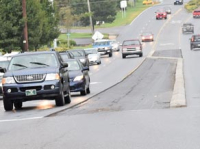Vandalism at Judaculla: Leaders discuss how to protect Cherokee landmark
 When Jerry Parker walked by Judaculla Rock on March 26, he saw that some newer markings covered the rock’s millennia-old Cherokee carvings. A symbol written in white spray paint blazed the rock’s center, black paint circled a pair of round rises near the bottom, and sets of initials covered the beams of the boardwalk surrounding the historic site.
When Jerry Parker walked by Judaculla Rock on March 26, he saw that some newer markings covered the rock’s millennia-old Cherokee carvings. A symbol written in white spray paint blazed the rock’s center, black paint circled a pair of round rises near the bottom, and sets of initials covered the beams of the boardwalk surrounding the historic site.
Parker, who is the rock’s unofficial caretaker and comes from the family that used to own the land in the Caney Fork area of Jackson County where the rock sits, said he was distraught at the “utter disregard that people have for things which are important and sacred and unique and one of a kind.”
“I have lived with the rock for 65 years,” said Parker, whose house is within sight of the rock. “I feel it’s a part of me, and when they do that it’s an attack on me. Generations of family members before me have been stewards here.”
The Cherokee people would say the same, though their connection to the rock extends to a time long before Parker’s ancestors arrived on the continent. The rock is named for the slant-eyed monster Judaculla, considered a great warrior and hunter in Cherokee legend. The story goes that Judaculla scratched the markings covering the rock into its face with his seven-fingered hands.
“The various stories, those are oversimplifications of who Judaculla was,” said Tyler Howe, tribal historic preservation specialist for the Eastern Band of Cherokee Indians. “Judaculla was a teacher of the Cherokee. He taught lessons of the right way to do things. There’s proper ways to hunt. There’s proper ways to be a man. There’s stories about humbleness. There’s stories about when people do bad things, how do you react.”
While nobody today is sure how to interpret the glyphs on the rock, that’s not to say they don’t have meaning.
Related Items
“Those are physical illustrations of the Cherokee landscape,” Howe said. “Being as old as they are, being as deeply imbedded in the cultural traditions as they are, that’s the kind of damage that’s being done.”
“This is not only the biggest and most densely carved (rock) in Western North Carolina, but it’s probably the most densely carved in the Southeast,” said Scott Ashcraft, archeologist for the U.S. Forest Service. “It’s intense.”
A string of incidents
The graffiti discovered at the end of March was just one in a string of recent incidents of vandalism at Judaculla, spread out over the space of a month or so. First Parker saw that somebody had chipped a piece of the rock off, a corner that formed a bowl-like shape on the lower end. It was after that the graffiti was discovered, and the Jackson County Sheriff’s Department then placed a pair of security cameras in nearby trees. Just three days after the graffiti incident, cameras snapped images of a man stealing one of the interpretive signs installed around the area. The sheriff’s office recently identified the man as 31-year-old Walker Chace Wadkins, whose listed address is in Bryson City, and is seeking to arrest him on charges of injury to personal property, misdemeanor larceny and possession of stolen goods.
Wadkins has spoken to investigators on the phone and led them to recover the sign but is not allowing himself to be arrested.
“He’s willfully hiding from us,” said Maj. Shannon Queen.
It’s possible that Wadkins could know something about the other recent vandalism incidents, but law enforcement doesn’t know for sure that the incidents were linked.
“I don’t have any evidence that they’re all exactly related, but it would seem logical,” Queen said.
Queen also said he can’t yet say for sure what the marking painted on the rock represents. However, Parker believes it’s a “pro era 47,” a combination of a 4 and a 7 that the American hip-hop collective Pro Era uses on one of its logos. The logo is supposedly intended to represent balance and peace but has been criticized for its similarity to a Nazi swastika.
In response to the vandalism, Jackson County hired the company Stratum Unlimited — which specializes in rock art conservation — to clean off the paint, a process that will take about four days and cost $3,800.
“Hopefully, all graffiti can be removed and that which cannot be removed will be camouflaged to match the surrounding rock surface,” said County Manager Chuck Wooten.
Damage to all of us
It’s good that the paint can be cleaned up, Parker said, but the vandalism still inflicts lasting injury to a site that’s been sacred to generations of Cherokee people. Every time paint is cleaned from a rock, a little layer of rock comes off with it.
“The rock can only withstand so many repeated insults like this,” Parker said. When he thinks back to what the rock and its carvings used to be when he was a child, and what they look like now, he’s saddened by the amount of denigration that’s occurred over that relatively short span of time.
“It seems the face of it is disappearing before my eyes in the last four decades,” he said.
That’s personal to Parker, who remembers a boyhood spent earning quarters from the tourists who would ask him to tell the legend of Judaculla. But it’s also personal to the Cherokee people and to Western North Carolina as a whole.
“It’s a deeply embedded story,” Howe said of Judaculla’s importance to the Cherokee. “But the physical rock itself, this project showed that we’re all stewards of that rock, and it’s important now to the story of Western North Carolina. Yes, it was damage to a Cherokee cultural site, but this project has shown that now it’s damage to all of us.”
Getting the rock to its current state was an undertaking that involved the Parker family, Jackson County, the U.S. Forest Service and the Eastern Band of Cherokee Indians. In 1959, Parker’s father transferred ownership of the land where the rock sits to the county, hoping the government could do more for its preservation than he could with his limited resources.
But it wasn’t until six or seven years ago that work began in earnest to give the rock the status it deserved.
At that time, “the rock was literally half-buried,” Ashcraft said. “Half of it was underground just because of years of erosion.”
With input from the Cherokee as to how to do so respectfully, the group brought the rock to the surface, built a boardwalk around it and installed interpretive signs to tell the story of the site.
“I’m proud of Jackson County,” Ashcraft said. “For being a little mountain county of modest means, they really stepped up on this.”
The fact that someone sprayed graffiti over all that hard work, he said, is “beyond sad.”
Keeping the rock secure
Going forward, the county will likely start talking about how to arrive at a more permanent security solution. The cameras that captured Wadkins’ image are battery-operated and not optimal for long-term use. It’s likely they’ll start discussing how to get some permanent cameras out there and methods for connecting them to a power supply.
“Since it’s in a more remote area of that community, it’s harder to protect because you don’t have as many people looking around and looking after it,” Queen said.
Howe is hoping to see community ownership of Judaculla and sites like it continue to increase in the future, and that that sense of ownership will contribute to the rock’s protection.
“People are really starting to recognize that, yes, there are ancient Cherokee cultural sites, but it’s also part of the story of Western North Carolina now,” he said. “It’s part of your community story. Help us protect it. I think that’s where our strength lies in the future of protecting these sites.”
Tips needed
The Jackson County Sheriff’s Department is currently seeking information on the whereabouts of Walker Chace Wadkins, 31, of Bryson City, in connection with vandalism at Judaculla Rock.
Report information to Jackson County Crime Stoppers, 828.631.1125.









